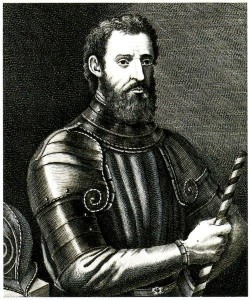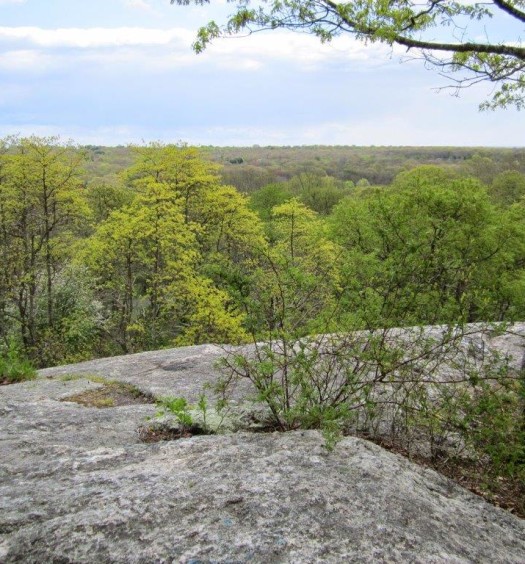The earliest written descriptions of Indians in North America were by Giovanni da Verrazzano, an Italian mariner commissioned by the King of France in 1523 to discover whether Asia could be reached by rounding the Americas to the north. He became the first European to sail the east coast from Florida to Nova Scotia. He observed that the coastline everywhere was “densely populated.” Of all the Indians he visited on this trip, he was most favorably impressed by the Narragansetts.
Verrazzano’s ship anchored in Narragansett Bay, probably near what is now Providence or Pawtuxent, Rhode Island. Verrazzano was one of the first Europeans the natives had seen, perhaps even the first, but the Narragansett were not intimidated. Almost instantly, twenty long canoes surrounded the visitors. Confident and graceful, two Narragansett sachems leapt aboard. The older one, about forty years old, was a tall, long-haired man with multicolored jewelry dangling about his neck and ears, while the younger man was about twenty-four-years old, both “as beautiful of stature and build as I can possibly describe,” Verrazzano wrote.
For fifteen days Verrazzano and his crew were the Narragansett’s honored guests—though the Indians, Verrazzano admitted, kept their women out of sight after hearing the sailors’ ”irksome clamor” whenever females came into view. Much of the time was spent in friendly banter. To the Europeans’ confusion, their steel and cloth did not interest the Narragansetts, who wanted to swap only for “little bells, blue crystals, and other trinkets to put in the ear or around the neck.”
On shore, Verrazzano noticed that the Narragansett’s “fields extend for 25 to 30 leagues; they are open and free of any obstacles or trees, and so fertile that any kind of seed would produce excellent crops.” Apparently, the Narragansetts used controlled burns to clear the land of trees, brush and briars, and making the land open for grazing for wildlife and for cultivation.
By the time the Pilgrims landed on Cape Cod, about one hundred years later in 1620, a dramatic transformation of the Native American population had occurred. The Wampanoag tribe and others to the north had suffered terribly from the diseases of white men, probably white fisherman. Indeed, the spot where the Pilgrims landed in Cape Cod had recently been the scene of a terrible illness, leaving it open for white settlement. To the south, the Narragansetts did not suffer as much from the disease as did the Wampanoags, but it appears that their population was not as dense as when Verrazzano visited in 1524.
One interesting controversy: how to spell Verrazzano. It is apparently acceptable to spell it with one “z” or two “”z’s.” The name of the Verrazano-Narrows Bridge connecting Brooklyn and Staten Island, as well as a smaller bridge in Maryland connecting Assateague Island , has only one “z,” while the Jamestown Verrazzano Bridge has two. Meriam Dictionary says the preference is one, and the Microsoft Word spell check likes one, but Google and Wikipedia use two. The Italian navy named a ship after the explorer using two; as a result of that and the Rhode Island bridge, I have used two in this article.
Excerpt of Letter from Giovanni da Verrazzano to King Francis I of France, July 8, 1524
We reached another land 15 leagues from the island, where we found an excellent harbor [current Narragansett Bay, probably the West Channel, near the mainland]. Before entering it, we saw about 20 boats full of people who came around the ship uttering various cries of wonderment. They did not come nearer than fifty paces, but stopped to look at the structure of our ship, our persons, and our clothes; then all together they raised a loud cry which meant that they were joyful. We reassured them somewhat by imitating their gestures, and they came near enough for us to throw them a few little bells and mirrors and many trinkets, which they took and looked at, laughing, and then they confidently came on board ship. Among them were two kings, who were as beautiful of stature and build as I can possibly describe. The first was about 40 years old, the other a young man of 24, and they were dressed thus: the older man had on his naked body a stag skin, skillfully worked like damask with various embroideries; the head was bare, the hair tied back with various bands, and around the neck hung a wide chain decorated with many different-colored stones. The young man was dressed in almost the same way.
These people are the most beautiful and have the most civil customs that we have found on this voyage. They are taller than we are; they are a bronze color, some tending more toward whiteness, others to a tawny color; the face is clear-cut; the hair is long and black, and they take great pains to decorate it; the eyes are black and alert, and their manner is sweet and gentle, very like the manner of the ancients. I shall not speak to Your Majesty of the other parts of the body, since they have all the proportions belonging to any well-built man.
Their women are just as shapely and beautiful; very gracious, of attractive manner and pleasant appearance; their customs and behavior follow womanly custom as far as befits human nature; they go nude except for a stag skin embroidered like the men’s, and some wear rich lynx skins on their arms; their bare heads are decorated with various ornaments made of braids of their own hair which hang down over their breasts on either side. Some have other hair arrangements such as the women of Egypt and Syria wear, and these women are older and have been joined in wedlock.
Both men and women have various trinkets hanging from their ears as the Orientals do; and we saw that they had many sheets of worked copper which they prize more than gold. They do not value gold because of its color; they think it the most worthless of all, and rate blue and red above all other colors. The things we gave them that they prized the most were little bells, blue crystals, and other trinkets to put in the ear or around the neck. They did not appreciate cloth of silk and gold, nor even of any other kind, nor did they care to have them; the same was true for metals like steel and iron, for many times when we showed them some of our arms, they did not admire them, nor ask for them, but merely examined the workmanship. They did the same with mirrors; they would look at them quickly, and then refuse them, laughing.
They are very generous and give away all they have. We made great friends with them, and one day before we entered the harbor with the ship, when we were lying at anchor one league out to sea because of unfavorable weather, they came out to the ship with a great number of their boats; they had painted and decorated their faces with various colors, showing us that it was a sign of happiness. They brought us some of their food, and showed us by signs where we should anchor in the port for the ship’s safety, and then accompanied us all the way until we dropped anchor.
We stayed there for 15 days, taking advantage of the place to refresh ourselves. Every day the people came to see us on the ship, bringing their womenfolk. They are very careful with them, for when they come aboard and stay a long time, they make the women wait in the boats; and however many entreaties we made or offers of various gifts, we could not persuade them to let the women come on board ship.
One of the two kings often came with the queen and many attendants for the pleasure of seeing us, and at first they always stopped on a piece of ground about two hundred paces away from us, and sent a boat to warn us of their arrival, saying they wanted to come and see the ship: they did this as a kind of precaution. And once they had a reply from us, they came immediately, and watched us for a while; but when they heard the irksome clamor of the crowd of sailors, they sent the queen and her maidens in a light little boat to wait on a small island about a quarter of a league from us. The king remained a long while, discussing by signs and gestures various fanciful notions, looking at all the ship’s equipment, and asking especially about its uses. He imitated our manners, tasted our food, and then courteously took his leave of us.
Sometimes when our men stayed on a small island near the ship for two or three days for their various needs, as is the custom of sailors, he would come with seven or eight of his attendants, watch our operations, and often ask us if we wanted to stay there any length of time, offering us all his help. Then he would shoot his bow and run and perform various games with his men to give us pleasure.
We frequently went five to six leagues into the interior, and found it as pleasant as I can possibly describe, and suitable for every kind of cultivation—grain, wine, or oil. For there the fields extend for 25 to 30 leagues; they are open and free of any obstacles or trees, and so fertile that any kind of seed would produce excellent crops. . . .
When we went farther inland we saw their houses, which are circular in shape, about 24 to 25 paces across, made of bent saplings. They are arranged without any architectural pattern, and are covered with cleverly worked mats of straw which protect them from wind and rain. There is no doubt that if they had the skilled workmen that we have, they would erect great buildings, for the whole maritime coast is full of various blue rocks, crystals, and alabaster, and for such a purpose it has an abundance of ports and shelter for ships. They move these houses from one place to another according to the richness of the site and the season. They need only carry the straw mats, and so they have new houses made in no time at all.
In each house there lives a father with a very large family, for in some we saw 25 to 30 people. They live on the same food as the other people—pulse [generally, vegetable foods such as peas and beans] (which they produce with more systematic cultivation than the other tribes, and when sowing [planting seeds] they observe the influence of the moon, the rising of the Pleiades, and many other customs derived from the ancients), and otherwise on game and fish. They live a long time, and rarely fall sick. If they are wounded, they cure themselves with fire without medicine; their end comes with old age. We consider them very compassionate and charitable toward their relatives, for they make great lamentations in times of adversity, recalling in their grief all their past happiness. . . .
[Banner Image: Excerpt from a map by Giacomo Gastaldi, Venice, 1556, showing Narragansett Bay in Rhode Island. “Port Réal” probably intends to show the Middle Passage and “Port de Refuge” probably intends to show the West Passage. “Brisa” is probably Block Island. (Private Collection)]For Further Reading:
Charles Mann. 1491. New Revelations of the Americas Before Columbus. New York, NY: Vintage, 2005.



























